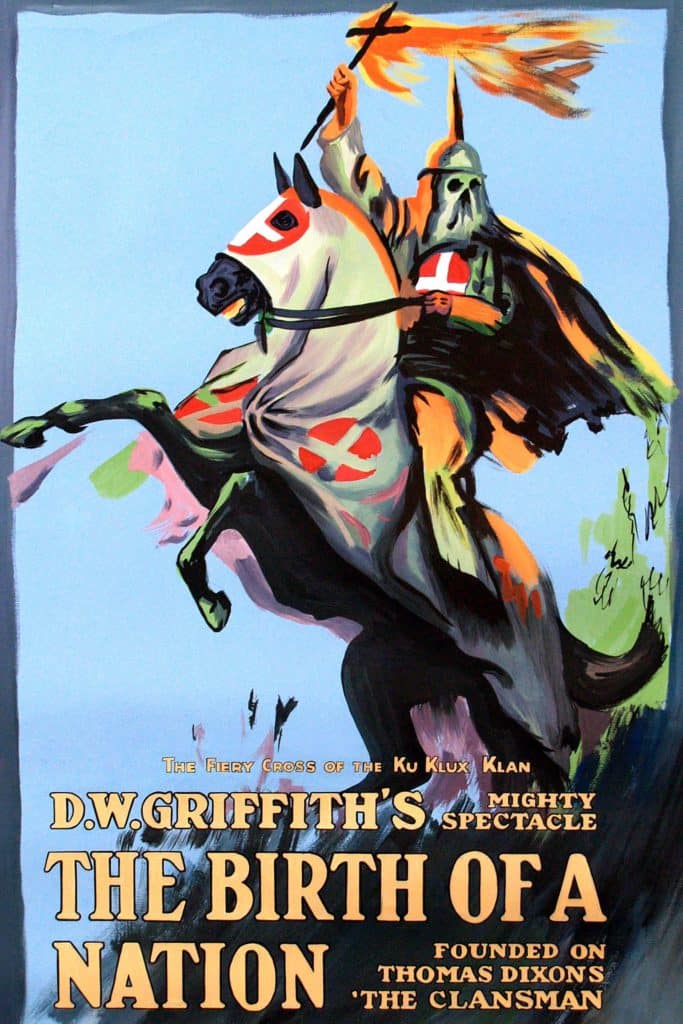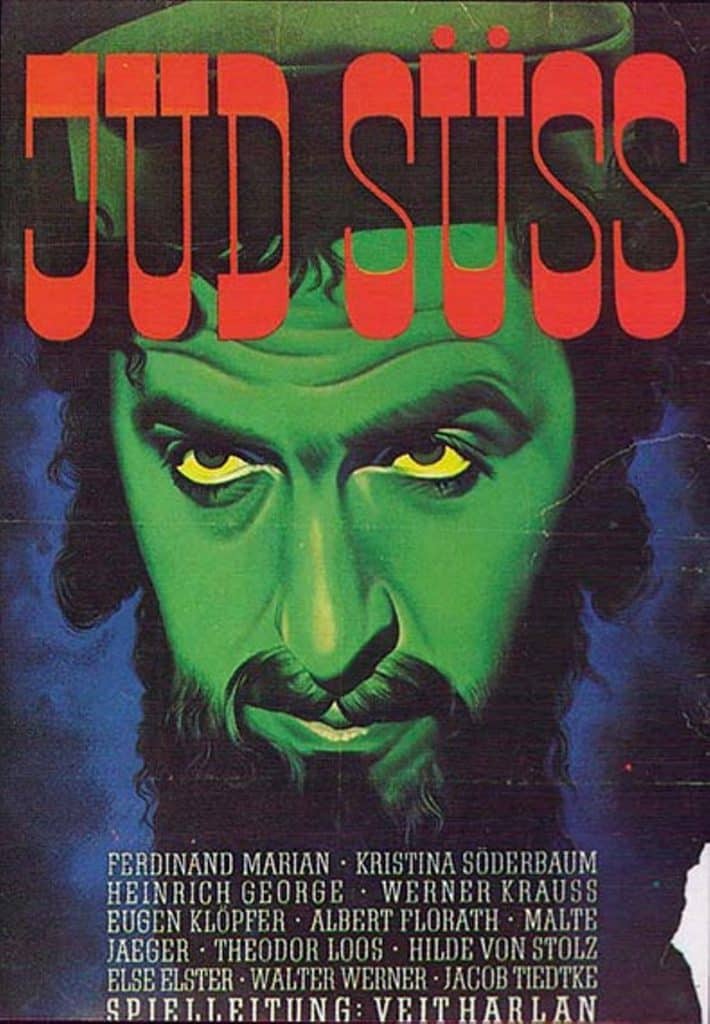Propaganda movies’ main goal is to incite hatred towards other ethnicities or races. This article reviews a few movies from different countries and historical periods: from Ku Klux Klan times with violent ideas to modern Russia with anti-Ukrainian propaganda.
How the first blockbuster praised Ku Klux Klan
In 1915 the world saw David Griffith’s film «The Birth of A Nation». It was the first Hollywood blockbuster, and it was also one of the most successful ones in the history of American cinema. This movie was technically and visually progressive at that time. Raising an issue of racial inequality and discrimination and praising Ku Klux Klan were also among the robust features of this movie.
There are two American families with different political views as the movie’s core story. During the Civil War, they appear on opposite sides of the barricades, with the Stonemans becoming North supporters and the Camerons defending the interests of the enslavers in the South. But they have no natural animosity due to mutual relationships and hardships. Moreover, after the war, the South changes quite unpleasant to some. While there was slavery, their life seemed to be so easy and nice to these people. In the movie, even some enslaved people acted as if they were okay with this situation. But when the entire slavery system crumbles, the Southern states find themselves in chaos.

Meanwhile, the Republicans (who were against slavery then) obtained key positions in the government. But instead of resolving issues in their country, they start suppressing the rights of some respectable Southern gentlemen, while people recently liberated from a slavery are shown to be falling to violence and lawlessness.
The later plot consists of even more propaganda. A tragedy occurs in Cameron’s family: a violent man Gas, a formerly enslaved person, becomes a reason for the death of young Flora. That’s when the above-mentioned Ku Klux Klan appears on the stage. Its member defended white Americans and attempted to restore order in the Southern states. They also lynch Flora’s abuser.
In this movie, representatives of both races are opposed to each other. White people are usually depicted in these movies as intelligent and highly cultural and treat those in slavery and servants well and remain honorable with the enemies on a battlefield. They meet all the hardships and challenges bravely. Meanwhile, black people (whose roles are performed by white actors with makeup) are depicted as rude, uncultured, vile, and aggressive. They resemble savages more than civilized people in these movies. In the movie, even though their social status has changed, formerly enslaved people cannot use their new rights and opportunities better. For example, they turn a voting process into an actual circus when they first get a chance to vote. One of them puts his dirty feet on the table, another one is chewing on a chicken leg, and others are simply getting drunk. However, there are «good black people» in these movies, those who serve their masters.
The movie «The Birth of A Nation» strongly influenced society back then. It even became an impulse to restore Ku Klux Klan in real life and caused many violent attacks against black Americans.
When propagandists need an enemy within
When the Nazis came to power in Germany in 1933, they immediately established total control over all the state media. Propagandists wanted to unite Germans against their «mutual enemy», Jews. Jewish people were depicted as some unfriendly and strange race that parasites the body of the hard-working Germans and destroys the German economy and culture.
The leading Reich propagandist Joseph Goebbels relied heavily upon cinematography in this regard. According to him, movies play a crucial role in establishing public opinion. After the events of the Crystal Night, the Nazi top establishment focused primarily on their anti-Semitic propaganda. Meanwhile, even German media criticized an outburst of violence against the Jewish community. It became clear that this policy didn’t have enough support from the population. It angered Adolf Hitler a lot. He wished to see propaganda on such a level that it would motivate Germans to initiate calls for violence.

After a disciplinary conversation with top officials, Goebbels took on to work. He ordered every film studio to produce its anti-Semitic movie. Thus, in 1940 a pseudo-historical propaganda movie, «The Eternal Jew» by Fritz Hippler. It was a response to the British film of the same name. The original movie told a story about Jewish people’s persecution and contained no anti-Semitic elements. However, Hippler depicted Jews in his movie as natural enemies who have harmed science, art, and culture for centuries. The film also demonstrates some elements of daily routine and transitions of Jewish people from different countries worldwide. Still, it was shown so that it would cause intense feelings of antipathy for the viewers. The movie also features documentary shots of a Jewish butcher at work, and this footage is quite disturbing in its nature.
There were also a few conspiracy theories around this movie. For example, it is stated in the film that baron Rothschild sent his sons to different European countries to find banks and make profits from wars. Jewish people are depicted in the movie as the real pestilence. They’re being compared to rats who flooded Europe and now consume its resources. The film ends with Hitler’s speech, where he declares Hewish people responsible for the war he started.
In 1940 another movie, «Jud Süß» by Veit Harlan, was released. This movie also came in response to another British film that Nazis considered a «pro-Jewish» one. The events occurred in that movie in 1733. Charles Alexander, the Duke of Württemberg, appoints a prosperous merchant Süß Oppenheimer as his financier. While holding this position, Oppenheimer came up with new custom fees and taxes and introduced special taxes for using public roads and bridges.
He destroyed half of a house of a local blacksmith who refused to pay the new increased taxes. And when an outraged man attacks the financier, the last orders to execute the man. Süß manipulates his spineless employer, encourages him to break the law, strips local councils of their powers, and exploits local villagers.
In Germany, over 20 million people watched this movie. This movie was used by the Nazis deliberately during their persecution of Jews. «Harlan’s movie «Jud Süß» is a great, a genius piece of art», Goebbels wrote in his diary. «It’s an anti-Semitic movie we can only wish for».
Entertainment movies with a propaganda taste
After the full-scale Russian invasion, a new wave of interest sparked in Aleksey Balabanov’s movies «Brother» and «Brother 2». Both these movies enjoy an iconic movie status among Russians, while the movie protagonist Danila Bagrov is considered a national hero. Even Putin quoted Danila’s monologue about the «power of truth» in his speech. There’s no wonder here! The movie «Brother» is just a criminal story of its times only from first sight. But even such entertainment movies reflect Russian imperial narratives and mark other ethnicities and nationalities’ representatives as enemies.
Both «Brother» movies are filled with chauvinism and racism. People of other races and nationalities are systematically humiliated and offended there, be that Ukrainians, Americans, Jewish people, Frenchmen, black Americans, and people from the Caucasus region. Danila regularly engages in conflicts with them, and when the situation escalates, he kills them without remorse.

In the movie’s second part, the main character Danila travels to the USA, where he helps his friend’s brother, who got into quarrels with the «Ukrainian mafia». And Danila solves all problems, obviously, with the help of guns. During a murder scene with two Ukrainian mafia guys in a public restroom, one can hear a phrase in the background, «You, bastards, will answer for Sevastopol!». This line still warms the heart of any Russian chauvinist. It is also interesting that this scene marks an appearance of a Nazi uniform fan and a weapons smuggler with the nickname Fascist. But he is a friend because he is Russian.
Ironically, Russian propaganda likes labeling Ukrainians as «fascists». This tendency is also noticeable in the movie «Were From the Future» directed by Aleksandr Samokhvalov and Boris Rostov. The events in that movie occur in Ukraine, where reformed neo-Nazis Bormann and Cherep (Skull) arrive to participate in the reconstruction.
They meet there, an aggressive «Western Ukrainian» Taras and a weak and cowardly rich man Siry. These people are pretty unpleasant, and their views and opinions are «distorted with the nationalist propaganda», according to the authors. But suddenly, all four of them find themselves in 1944, where they witness how inhumane and violent «banderovites» execute locals. That’s when Taras and Siry change their views drastically. Constant interaction with the «right» and «good» Russian guys also plays its role, apparently. The friends not only turn to the «side of light» but even switch to speaking only Russian, as a decent and reasonable person would never talk to Ukrainian.
A similar message could be seen in the movie «Match» by Andrey Malyukov. All traitors, collaborationists, and thieves speak Ukrainian in this movie. By the way, a leading actor in this movie, Sergei Bezrukov, publicly supported the Russian invasion of Ukraine. Before that, he openly supported the Russian annexation of Ukrainian Crimea. One of the «Match» screenwriters, Timofey Sergeytsev, wrote an article right after the Russian invasion and called it «What Russia Has To Do With Ukraine» where he openly called for the terror of genocide of Ukrainians.
After the annexation of Crimea and the occupation of some parts of the Donbas region, the Russian propaganda machine worked with a new intensity. Shortly a movie, «Crimea» directed by Aleksey Panfilov, was released. The director shows the annexation of Crimea as the greatest good and portrays Russia as a savior and liberator. The movie protagonist, Sanya, a former soldier, significantly likes the Northern neighbor. And he also hates «banderovites» and supports the «Berkut» riot police when they violently dispersed protests during Euromaidan. In this movie, evil Euromaidan supporters were burning buses and terrorizing peaceful locals in Crimea. In the meantime, the «Berkut» riot police are depicted as real heroes deserving of respect. At the movie’s end, Sanya heads to Donbas to fight on the Russian side.
The events in Donbas in 2014 also caused high interest among Russian filmmakers. For example, Renat Davletyarov, in his film «Donbas. The Outskirts» shows the war as a «civil conflict». Russian military aggression is being denied; the movie doesn’t show any Russian soldiers, weapons, or equipment. However, all Kremlin cliches and narratives are still there: a bloody «junta» that seized power in the country and merciless Ukrainian «punitive squads», and a constant opposing of a bad Ukrainian soldier and an excellent pro-Russian militant.
Other Russian filmmakers, Maksim Brius and Mikhail Wasserbaum, are using these cliches in their movie «Hot Sunlight». There is also genocide of Russian-speaking people, violent and ruthless «Right Sector» fighters, and American mercenaries who fight for Ukraine in Donbas. Ukrainian soldiers and all Ukrainians are shown as enemies in this movie. They are held responsible for the war and accused of terrorizing the people of Donbas. Ukrainians are portrayed in this movie only as murderers, torturers, rapists, and moral monsters who can only fight against unarmed civilians. And, of course, «good and heroic militants» are their total opposite.
Cinema is much more than just a form of entertainment for your night. As with any other state-of-the-art, cinematography can spread and advocate for specific ideas and impact people’s worldviews and opinions. It’s especially true for cases when the authors are not artists but propagandists with the help of cinema. They can label other people, push their imperial ideas and chauvinist narratives, and incite hatred and intolerance. And that’s what Russia has been doing for years.








